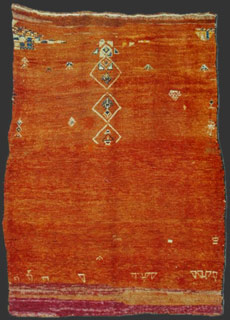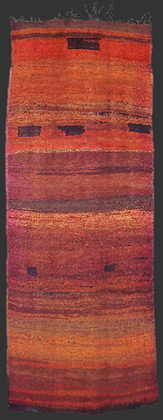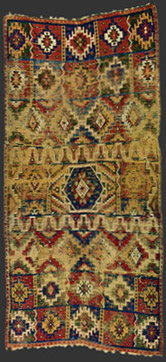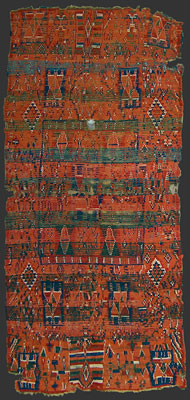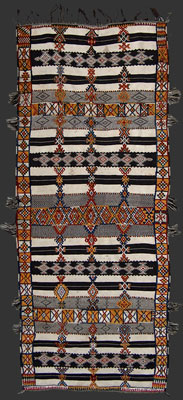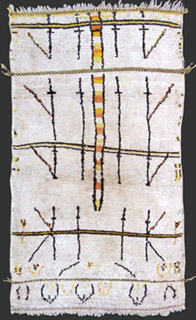|
© GEBHART BLAZEK Morocco's rural weaving culture has attracted a great deal of attention from the international art world over the past 20 years. Much of this interest has been generated by a new generation of dealers and collectors who have used their understanding and appreciation of abstract modern art to judge these weavings, thereby gradually replacing the use of fineness, natural dyes and age as indicators of quality. |
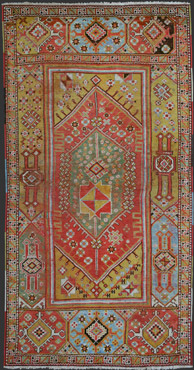 |
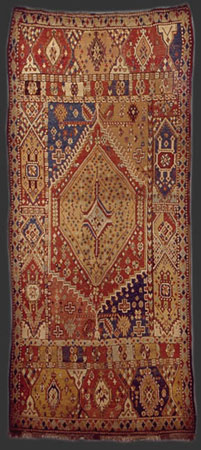 |
|
| (1) antique Rabat carpet around ca. 1750, ca. 295 x 160 cm (9' x 5'), the relation to so called "Transylvanian" carpets from western Anatolia is very evident. | (2) antique Rabat carpet around ca. 1800, ca. 380 x 165 cm (12' 8'' x 5' 6''), the design becomes denser and the entire field is significantly enhanced by Moroccan local motifs. | |
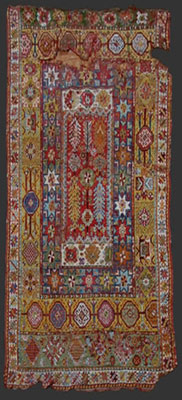 |
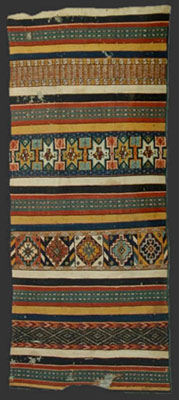 |
|
| (3) antique Rabat carpet around ca. 1840, ca. 350 x 165 cm (11' 8'' x 5' 6''), a typical example from the first half to mid of the 19th century. The design becomes very dense, multiple borders dominate the composition while the central field has almost vanished. The color palette becomes more and more diverse. | (4) antique hanbel (mixed technique textile) from Salé, second quarter 19th century, ca. 350 x 140 cm (11' 8'' x 4' 8''). The decoration of these textiles mainly consits of weft substitution designs similar to those found all over the Middle Atlas; in addition there are typically three horizontal panels of knotted design with the pile side pointing to the back of the textile. |
| RURAL RUGS |
|
The mountainous regions of the Middle Atlas reach heights of up to 3200m in the most northern part around the Jebel bou Iblane and have the most severe climate in Morocco during the winter. |
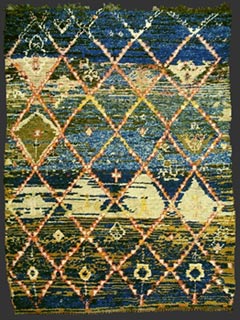 |
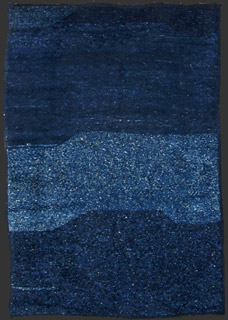 |
|
| (5) Beni Mguild pile rug, western central Middle Atlas, ca. 1920/30, ca. 240 x 170 cm (8' x 5' 8''). | (6) Beni Mguild pile rug, western Middle Atlas, ca. 1920, ca. 220 x 150 cm (7' 4'' x 5'). | |
|
The main design concept of Middle Atlas carpets, normally based on an overall diamond grid (5, 7), can oftenchange during the course of being woven and these “conceptual fractures” become obvious features of the finished piece. Indeed in making these carpets, a consistent composition seems to have been less important than having the flexibility to modify the rug's composition as soon as a new idea comes to mind (8, 10). |
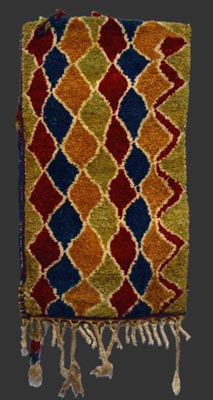 |
|
|
|
(7) Beni Jelidassen pile woven pillow, north-eastern Middle Atlas, late 19th / early 20th cent., ca. 75 x 40 cm (30'' x 16'') |
(8) Beni Mtir pile rug, western Middle Atlas, ca. 1920, ca. 265 x 190 cm (8' 10'' x 6' 4'') |
|
|
As these carpets were mainly made for every day’s use a good number of them are extremely simple, with very reduced designs or even a plain monochrome field without any decoration ( 6, 8, 9, 10, 11). Representative carpets made with the help of a master weaver with a higher degree of decoration were rare in the Middle Atlas (12). |
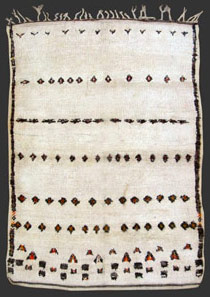 |
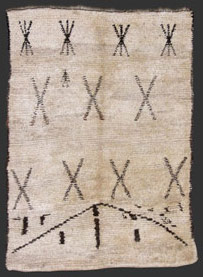 |
|
|
(9) Beni Mguild pile rug, western Middle Atlas, ca. 1930, ca. 235 x 170 cm (7' 10'' x 5' 8'') |
(10) Marmoucha or Ait Seghrouchene pile rug, eastern Middle Atlas, ca. 1920/30, ca. 205 x 155 cm (6' 10'' x 5' 2'') |
|
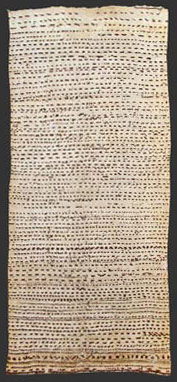 |
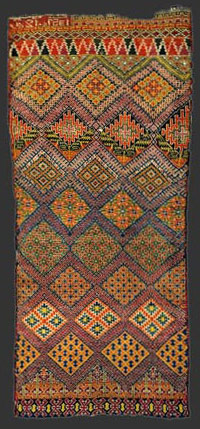 |
|
|
(11) antique Beni Ouarain pile carpet, north-eastern Middle Atlas, late 19th / early 20th cent., ca. 400 x 175 cm (13' 4'' x 5' 10'')
|
(12) Marmoucha pile carpet, eastern Middle Atlas, dated 1354 AH (= 1933 AD), ca. 380 x 175 cm (12' 8'' x 5' 10''). The dense and more complex design is charcteristic for the work of a male professioonal master weaver . coll. L. Viola, Marrakech. publ. HALI 120, p.75 |
|
The region's flatweaves however are highly technically complex and have dense decoration (13, 14, 15). On the western side of the Middle Atlas the designs of some pile carpets are clearly based on ideas seen in flatweaves, in particular in the region of the Beni Mguild, Beni Mtir and Ait Youssi. Occasionally these carpets appear like enlarged details of flat-woven examples (16). |
 |
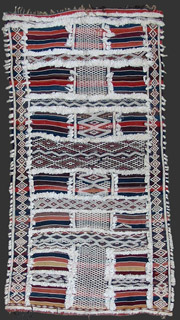 |
|
|
(13) Beni Mguild kilim (hanbel), western central Middle Atlas, early 20th cent., 250 x 145 cm (8' 4'' x 4' 10'') |
(14) Beni Mtir kilim (hanbel), north western Middle Atlas, early 20th cent., ca. 250 x 125 cm, (8' 4'' x 4' 2'') |
|
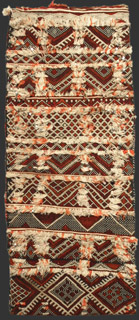 |
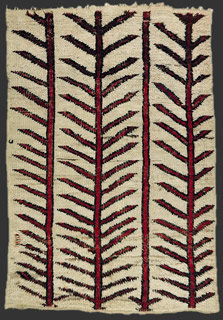 |
|
|
(15) Beni Alaham or Ait Seghrouchene pillow, northern Middle Atlas, ca. 1930/40, ca. 100 x 40 cm (40'' x 16'')
|
|
(16) Beni Mguild rug, western Middle Atlas, mid 20th cent, ca. 250 x 175 cm (8' 4'' x 5' 10'')
|
|
EASTERN MOROCCO
Although the carpets from Eastern Morocco have attracted little scholarly as well as commercial attention, their importance and influence on the development of rural Moroccan weaving culture - particularly on the one of the Middle Atlas - cannot be underestimated. As in the Middle Atlas, the carpets were generally used as sleeping mats and covers but due to the lower regions and the milder climate they only have a pile about 2cm high, and various forms of symmetric knots, asymmetric knots as well as the Berber knot are used. The sizes normally vary between 160 and 220 cm in width and from 3 up to 10 meters in length. Pile carpets in Eastern Morocco can be subdivided into a female style similar to the traditions in the Middle Atlas and a male style, which has an affinity to the traditions in Algeria and Tunisia. While the women produced the carpets for their own families in a self supporting nomadic economic system, the male traditions base on a system of specialised professional masterweavers (Arab.: mallem). The very large masterweaver carpets, sometimes up to 10 meters long, were made for wealthy families among the northern tribes of the Metalsa, Beni bou Yahi, Beni bou Zeggou and the Beni Snassen. Such pieces were regarded as extremely prestigious and served as examples and source of inspiration for the more widespread female carpet production. Occasionally the eastern Moroccan masterweavers also worked in the northern and eastern middle Atlas and hence were of significant influence to these regions too. The design scheme of these carpets shows the traditional simple geometric Berber motifs such as lozenges, triangles, crosses etc. inscribed in a regular, symmetric overall lozenge grid-composition with well balanced colours containing high amounts of deep indigo blue and green in old examples. Borders are typical, but usually the ones along the selvages differ clearly from the ones at the beginning and the end (17). |
 |
| (17) antique Beni bou Yahi professional masterweaver's carpet; lower Moulouya valley, eastern Morocco, ca. 1910/15, ca. 790 x 180 cm (26' x6') |
|
|
|
Otherwise among all the tribes cited above carpets have also been woven by women for everyday uses. Similar to the carpets of the Middle Atlas, the style of these pieces is based on free, abstract, borderless compositions. The designs are developed out of an inexact memory of previously seen examples and therefore lead to very free, often anarchic images (18 + 19).
Probably the most impressive ones of these female carpets come from the region of the Ait Seghrouchène du Sud in the most eastern portion of the High Atlas, from the sub - group of the Ait bou Ichaouen. |
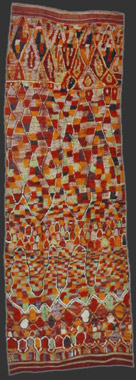 |
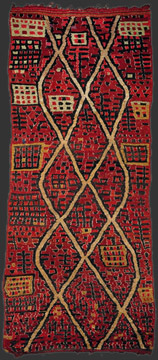 |
|
| (18) Ait bou Ichaouen rug, eastern Morocco, ca. 1940, ca. 430 x 150 cm (14' 4'' x 5') | (19) Zkara rug, north eastern Morocco, ca. 1920/30, ca. 430 x 180 cm (14' 4'' x 6'). publ. HALI 120, London 2002, p. 77 | |
|
HAOUZ The Haouz is a landscape of hills and plains situated between the Middle Atlas and the Atlantic ocean mostly inhabited by Arabic groups and arabised Berbers.
In the region around Boujad, in the eastern part of the Haouz, carpets come close to the ones from the Middle Atlas in their coarse structure, but designs do not seem to follow traditional rules. Even if the very basic formal canon of simple lozenges, squares or triangles is seen, the freedom of each individual weaver dominates the composition in a very personal pictorial language. Free floating forms and often rather sharp colours are said to be preferred by the rural Arabic taste. The region seems to be a melting pot of small migrations that took place during the French Protectorate and the last decades. So the specific regional pile weaves do not have a far-reaching history in the traditional sense, but rather represent a recent cultural phenomenon. Nevertheless they carry a very distinctive character and the best examples may be regarded as charming works of art (20). |
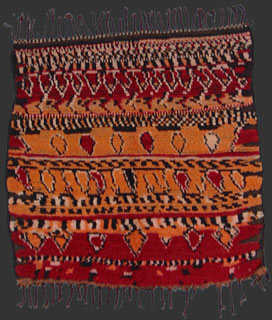 |
(20) saddle rug from the region around the city of Boujad, eastern Haouz plains, ca. 1920/30, 85 x 81 cm (33,5'' x 32'') |
|
In the central and western areas of the Haouz, four main groups, the Rehamna, the Oulad bou Sbaa, the Ahmar and the Chiadma are known as carpet producing tribes. Owing to the mild climate, the rugs of this region mostly have – at least in pieces manufactured before 1930 – a rather fine structure executed in a symmetric knot and a pile height of around 8mm. A high number of weft shots between each row of knots causes a flat laying pile and gives a maximum effect to the lustrous wool in the old examples. Black saw tooth selvages in goat’s hair and a goat hair warp are typical for the region.
The carpets of the Haouz may be split into two groups: monochrome examples with a reddish orange ground are called gtifa and only sometimes carry small enigmatic motifs in an otherwise open empty field (21). Carpets called zarbia meanwhile have a more or less dense drawing of either motifs borrowed from urban Rabat carpets or designs in a typical regional style which seems to come closer to free abstraction than to a strict traditional canon of explicit motifs. In this style, which is mostly found in the rugs of the Rehamna and Ahmar, wavey lines, lozenges, triangles, squares, chessboard designs and sometimes even anthropomorphic and zoomorphic figures are typical features as well as borderless overall conceptions (22). In the Chiadma and the Oulad bou Sbaa rugs – especially in the very fine examples from Chinnani – urban influenced compositions and motifs dominate, sometimes mixed up with local elements or done in individual interpretations. These weavings usually carry at least one surrounding border. Chiadma carpets tend to have a rather high amount of yellowish orange and violet instead of the red ground colour. |
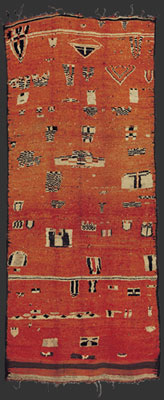 |
|
|
| (21)Rehamna carpet of the more densely decorated "zarbia" type, Haouz plains, ca. 1920, ca. 390 x 170 cm (13' x 5' 8'') | (22) Rehamna carpet of the less decorated "gtifa" type, Haouz plains, ca. 1930, ca. 440 x 175 cm (14' 8'' x 5' 10'') |
|
SOUTHERN MOROCCO AND HIGH ATLAS
The carpets from the southern Moroccan Jebel Siroua region and the Pre-Sahara are in general the finest examples of Moroccan rural weaving. In the past they have been traded under a quite misleading attribution to the “High Atlas” while the carpets from the Azilal province – really originating from the High Atlas – have been almost unknown to the market until the late 1990s. As the climatic circumstances on the northern end of the Sahara and the central High Atlas are far less severe than in the more northern mountainous regions, the carpets from southern Morocco tend to have a fine structure and a more noble appearance due to their extremely lustrous wool and an almost cloth-like touch. The tribes of the Ait Ouaouzguite confederation are the keyholders of the most sophisticated textile culture in rural Morocco. There is significant evidence for a mutual influence of the weavings from the urban centres of Rabat and Salé and the ones from the Ait Ouaouzguite at least from the early 19th century on (23, 24), based on one side on the closeness of the trans-Saharan trade routes to the region of the Jebel Siroua and on the other side on the cultural relations between the Jewish populations among the Ait Ouaouzguite and in the capital of Rabat. The highly skilled textile culture of this region is also expressed in various flatweaves and in a specific type of mixed technique textiles (25, 26). |
|
|
|
||
|
(23) antique Ait Ouaouzguite rug, Jebel Siroua region, mid 19th cent., ca. 310 x 140 cm (10' 4'' x 4' 8'')
|
(24) antique Ait Ouaouzguite (Ait Tamassine) rug, Jebel Siroua region, mid 19th cent., ca. 350 x 165 cm (11' 8'' x 5' 6'')
|
||
|
|
 |
|
|
| (25) antique Ait Ouaouzguite (Ait Ouarghada) textile, so called "Glaoui" type, Jebel Siroua region, 19th cent., ca. 355 x 145 cm (11' 10'' x 4' 10'') | (26) antique Ait Ouaouzguite (Ait Tamassine) textile, so called "Glaoui" type, Jebel Siroua region, late 19th cent., ca. 600 x 155 cm (20' x 5' 4'') |
|
While polychrome carpets with field compositions related to Rabat carpets from the late 18th and early 19th centuries are known only from some of the central Ait Ouaouzguite groups, more simple carpet types are known from all over the Jebel Siroua region (27) and the southern neighbouring areas of the Zenaga and Sektana. While the Ait Ouaouzguite developed an organized tradition of distinctive designs and motifs (28), which sometimes used central medallions and borders, the more southern tribes – in particular the Zenaga – tend to free floating forms, improvisation and a very individual formal language (29, 30).
|
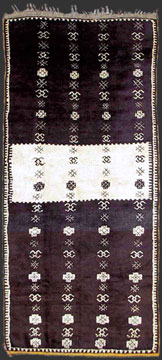 |
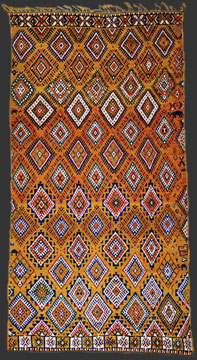 |
|
|
(27) Zenaga rug, southern Jebel Siroua region / Pre-Sahara, early 20th cent., ca. 290 x 130 cm (9' 8'' x 4' 4'')
|
(28) antique Ait Ouaouzguite (Ait Ouarghada rug, Jebel Siroua region, late 19th cent., ca. 290 x 155 cm (9' 8'' x 5' 2'')
|
|
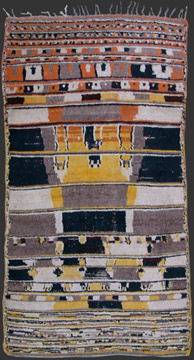 |
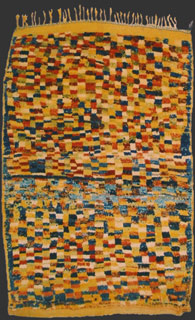 |
|
|
(29) Zenaga rug, south western jebel Siroua region / Pre-Sahara, ca. 1930, ca. 240 x 140 cm (8' x 4' 8'')
|
(30) Zenaga rug, south western jebel Siroua region / Pre-Sahara, ca. 1930, ca. 200 x 130 cm (6' 8'' x 4' 4'')
|
|
Beside these southern Moroccan regions, the High Atlas itself seems to have been rather poor in carpet production in comparison to the Middle Atlas. The only region with a pile-weaving tradition seems to exist in the province of Azilal, where the Ait Shokmane, the Ait Bougmez, the Ait Bouzid and the Ait bou Oulli produced white grounded carpets with designs executed in undyed brown or black wool. Only in rare cases the black and white scheme appears highlighted with few additional colours (31). Motifs and compositions seem to be related to the Middle Atlas as well as to the Ait Ouaouzguite, but in most examples free compositions of basic geometric elements show a very personal, archaic looking expression (31, 32). <read more>
|
|
|
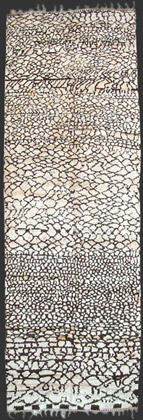 |
|
|
(31) Azilal rug, central High Atlas, ca. 1940/50, ca. 200 x 120 cm (6' 8'' x 4') |
(32) Azilal rug, central High Atlas, ca. 1950, ca. 415 x 140 cm (13' 10'' x 4' 8'') |
|
It is evident that Moroccan carpet culture is significantly different both in its structure and its history to that of the Orient. While urban production was related to and inspired by other cultural centres in the Mediterranean hemisphere, influences from Morocco towards the exterior are not documented. |
|
This text has originallly been published as a catalogue contribution to the exhibition "Moroccan Charm - Art of the Berber Tribes, The G. Blazek Collection of Carpets and Textiles and the I. Grammet Collection of Jewellery", held from July 2005 until April 2006 at the L. A. Mayer Institute for Islamic Art , Jerusalem, Israel. All items with the exception of the numbers 1, 2, 3, 4, 12, 17, 18, 19, 21, 22, 23, 24, 25 have been exhibited and are published in the catalogue which is either available at the L. A. Mayer Institute or through my 'books + catalogues' section. all photos © by Gebhart Blazek |
| ---------------------------------- |
|
footnotes: *1 C.G. Ellis: „Mysteries of the Misplaced Mamluks“, Textile Museum Journal, II, N° 2, 1967 *2 M. Bruzen la Martinière: „ Le Grand Dictionnaire Géographique et Critique“, tome second, Venice 1737, p. 91 (...“ Ils n’ont presque point des meubles, & leur lit consiste en un matelas étendu sur des ais depuis un muraille jusqu’à l’autre...“ .... „ Ils n’ont ni tables, ni chaises, ni escabeaux, ils ne font qu’étendre un grand tapis par terre, avec des coussins carrez, sur quoi les personnes de qualité s’asséient“....) *3 Prosper Ricard: „Corpus des Tapis Marocains“, tome 2, Tapis du Moyen Atlas, Paris 1926, re-edition 1975, p. 28, p. 31 – 51, p. 69 - 71 *4 Prosper Ricard: Prosper Ricard / Marcel Vicaire: „Corpus des Tapis Marocains“, tome 5 / fascicule1, Rabat 1950
further bilbliography: Wilfried Stanzer: Berber / Stammesteppiche und Textilien aus dem Königreich Marokko, Graz 1991, M. Messaouidi / W. Stanzer (editors), ICOC catalogue, Casablanca / Lieboch, 1997, lecture Gebhart Blazek: Textiles and Carpets of the Beni Ouarain and their Sub-Tribes: Differences and Differentiations / Les textiles et les tapis des Beni Ouarain et de leurs sous-groupes: différences et délimitations / Textilien und Teppiche der Beni Ouarain und deren Untergruppen: Unterscheidungen und Abgrenzungen Kurt Rainer: Marokko mon amour / Morocco mon amour, Graz 2005 Rachel Hasson / Gebhart Blazek: Moroccan Charm, Art of the Berber Tribes, Jerusalem 2005
Wikipedia: Berber carpet |



